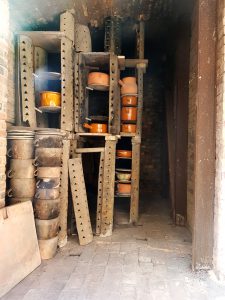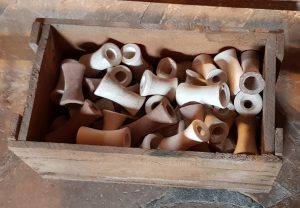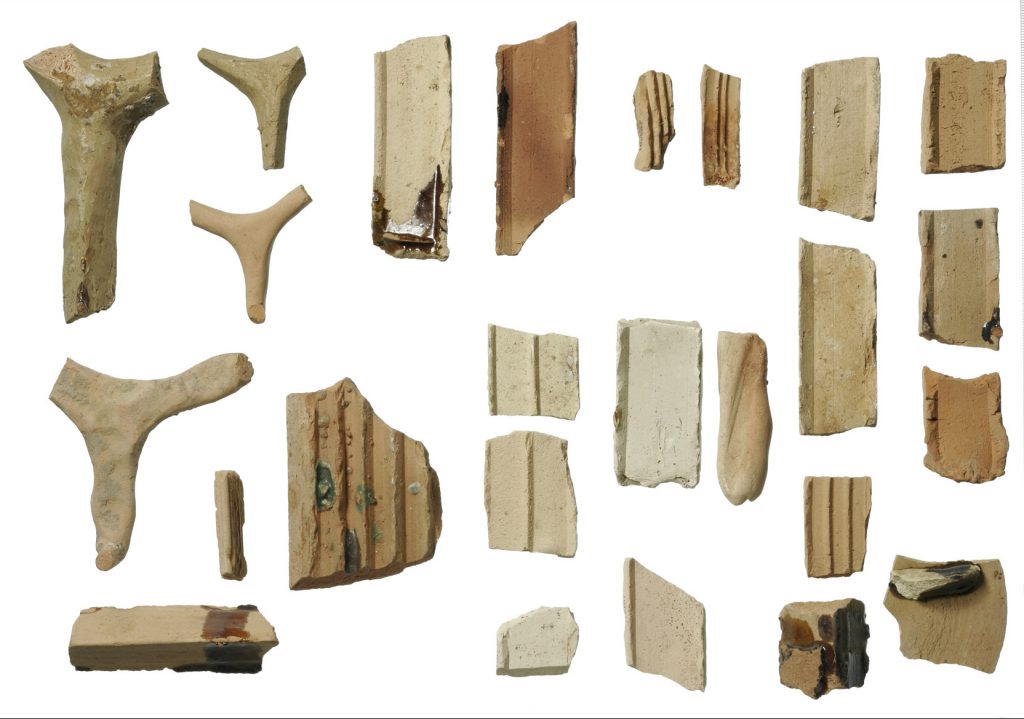

Kiln furniture and props in Vallauris, France, 2019.

Bern, Brunngasshalde, kiln furniture from the city’s refuse dumps, pre 1832 (photo by Badri Redha, Archaeological Service of Canton Bern)
Andreas Heege, 2019
The umbrella term “kiln furniture” refers to all objects used to load a potter’s kiln, ranging from simple spacers (lumps, balls or rolls of wet clay used to prop up the individual objects; e.g. Matthys 2005), to specially made stilts or saddles used by earthenware manufacturers, to stackable props and setters or cranks designed for specific vessel shapes used in faience and porcelain factories and the pottery industry in general. Ultimately it was the type of pottery, the kind of glaze, the shape of the individual object, the effort involved in its production and the method of loading the kiln (open with batts and props or closed in saggars) that determined whether and what specific type of kiln furniture was used. A large variety of shapes were used and some were specific to a particular potter or workshop (e.g. special kiln furniture designed for the production of stoneware storage vessels from Langerwehe).
The oldest depictions of fairly advanced and specialised kiln furniture and firing capsules or saggars can be found in a 1575 manuscript by Cipriano Piccolpasso (Lightbown/Caiger-Smith 1980). In Switzerland, kiln furniture does not appear to have been used until the late 16th century (Roth Heege/Thierrin-Michael 2016; Bänteli/Bürgin 2017, esp. Fig. 183). However, no systematic collection of kiln furniture has so far been compiled. The main types included batts, props, saggars, ring stilts, peephole plugs, pins/pegs, tripod stilts (trivets or cockspurs), saddles, spurs or pyramid-shaped wedges. Roof tiles and bricks were also used to create firing shelves and props inside the kiln (Babey 2016; Boschetti-Maradi 2006; Heege 2011; Heege/Kistler 2017; Matter 2012).
Translation Sandy Haemmerle
German: Brennhilfen
French: supports de cuisson, auxiliaires pour la cuisson, matériel d’enfournement, plaques, dalles et supports d’enfournement céramique, matériel d’encastage, éléments de calage, gazetterie, moufles, capsules, cassettes, gazettes, cazettes, étui, lanterne de terre, manchon, cerces, pernettes, accots, rondeau, renversoir, cerces
References:
Babey 2016
Ursule Babey, Archéologie et histoire de la terre cuite en Ajoie, Jura Suisse (1750-1900). Les exemples de la manufacture de faïence de Cornol et du centre potier de Bonfol (Cahier d’archéologie jurassienne 37), Porrentruy 2016, 160-166.
Bänteli/Bürgin 2017
Kurt Bänteli/Katharina Bürgin, Schaffhausen im Mittelalter – Baugeschichte 1045-1550 und archäologisch-historischer Stadtkataster des baulichen Erbes 1045-1900 (Schaffhauser Archäologie 11), Schaffhausen 2017.
Blondel 2001
Nicole Blondel, Céramique: vocabulaire technique, Paris 2001.
Boschetti-Maradi 2006
Adriano Boschetti-Maradi, Gefässkeramik und Hafnerei in der Frühen Neuzeit im Kanton Bern (Schriften des Bernischen Historischen Museums 8), Bern 2006, 33-45.
Heege 2011
Andreas Heege, Langenthal, St. Urbanstrasse 40–44. Die Hafnerei Staub und ihre Werkstatt, in: Archäologie Bern/Archéologie bernoise. Jahrbuch des Archäologischen Dienstes des Kantons Bern, 2011, bes. 229-234 (mit älterer Literatur).
Heege/Kistler 2017
Andreas Heege/Andreas Kistler, Keramik aus Langnau. Zur Geschichte der bedeutendsten Landhafnerei im Kanton Bern (Schriften des Bernischen Historischen Museums 13), Bern 2017, bes. 179-183.
Lightbown/Caiger-Smith 1980
Ronald Lightbown/Alan Caiger-Smith, Cipriano Piccolpasso, I tre libri dell’arte del vasaio = The three books of the potter’s art: a facsimile of the manuscript in the Victoria and Albert Museum, London, London 1980.
Matthys 2005
Catherine Matthys, La production présumée de Jacques Bertrand Visnon, potier de Bouffioulx vers 1600. Recherches récentes en Wallonie (Etudes et documents, Archéologie 8), Namur 2005.
Matter 2012
Annamaria Matter, Die archäologische Untersuchung in der ehemaligen Porzellanmanufaktur Kilchberg-Schooren. Keramikproduktion am linken Zürichseeufer 1763-1906 (Monographien der Kantonsarchäologie Zürich 43), Zürich 2012, 65-76.
Roth Heege/Thierrin-Michael 2016
Eva Roth Heege/Gisela Thierrin-Michael, Oberaltstadt 3/4, eine Töpferei des 16. Jahrhunderts und die Geschichte der Häuser, in: Eva Roth Heege, Archäologie der Stadt Zug, Band 2 (Kunstgeschichte und Archäologie im Kanton Zug 8.2), Zug 2016, 10-154.

